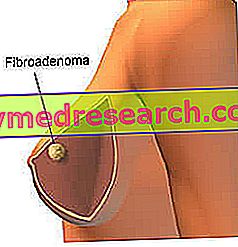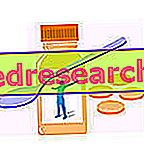Stages of antidepressant drug therapy
Treatment with antidepressants has as its main purpose the remission of the disease, restoring a good state of health - physical, mental and social - in the patient suffering from depression. Another goal of the therapy is to prevent the relapse phases.

- Initial or acute phase: its purpose is to bring about the remission of the symptoms of the disease, reducing the risks and the consequences related to it.
This first step lasts from 6 to 12 weeks; the main objective is to bring the patient back to the conditions prior to the onset of the disease. The antidepressant treatment is not an immediately effective treatment, in fact it takes a few weeks for the effect of the drug to be evident. In the beginning you can experience a slight improvement after about a couple of weeks from the beginning of the administration of the drug, to then reach a consolidation in the following weeks. Before deciding on the type of drug and the type of treatment, it is advisable to carry out a detailed clinical analysis, to evaluate the individual's family history, personal history and any other concomitant disorders. Moreover, in the choice of the drug it is necessary to take into account the psycho-biological context of the sick subject, on which an eventual molecule will act.
On the basis of these considerations there are general and specific criteria that allow to identify the best drug for each patient. Regarding the general criteria are included: the psychopharmacological history, or the effectiveness of any previous treatments, the data concerning the patient, the effectiveness of the chosen antidepressant drug, side effects and interactions with other drugs.
Considering the specific aspects, they refer to the evaluation of the severity of the illness and to the subtype of depression that afflicts the subject in question, together with an evaluation of the clinical course. Other specific characteristics are for example pregnancy and / or breastfeeding, age and the simultaneous presence of other diseases.
At the end of this analysis, we pass to the titration of the selected active ingredient and to the identification of the minimum effective dose. Drugs that have few side effects and are well tolerated by patients allow the achievement of the therapeutic dose fairly quickly. Afterwards, the real drug treatment begins.
- Follow-up phase: includes the treatment period which aims to avoid possible relapses. This phase begins after having achieved a good result during the acute phase of the disease. Usually this phase lasts for about four to six months following the complete restoration of the psychic balance of the sick subject. There are cases in which the continuation phase continues for eight to ten months.
If, after this time, it is not considered necessary to continue with maintenance therapy, based on the results obtained, it is possible to decide for the suspension of treatment, progressively reducing the dosages. The patient must be monitored during the gradual suspension of treatment.
- Maintenance phase: the main purpose of this phase is to prevent the so-called relapses. Compared to the previous phases, which have curative purposes, maintenance has a preventive purpose.
- Suspension or interruption phase: the suspension of drug treatment begins when the sick person has responded positively to all the previous phases. A very important precaution to be observed once it has reached this last phase is to avoid the abrupt withdrawal of the drug. Instead, the dosage should be gradually reduced and controlled for a period of two to four weeks. The suspension carried out in this way avoids the onset of symptoms such as anxiety, irritability, insomnia, sweating and general malaise.
What is meant by "treatment resistant depression"?
The term refers to cases in which the sick subject does not respond correctly to the pharmacological treatment with antidepressants. Specifically, we talk about treatment-resistant depression when there is an absence of response to at least two drugs that belong to two different classes and that are used according to the therapeutic regime. It has been found from numerous studies that among individuals in whom major depression has been diagnosed, approximately 30-50% of subjects do not respond adequately to the first treatment with antidepressant drugs. Not only that, it has been observed that even after multiple changes in trying to find the best drug, up to 10% of individuals affected by depression continue to show residual symptoms of the disease.
Predictive factors of drug resistance
Currently the predictive factors of drug resistance have been divided into two groups: socio-demographic factors and clinical factors. For example, among the socio-demographic factors it has been observed that the female gender is more predisposed not only to the development of the disease, but also to develop resistance to the subsequent treatment. Considering the clinical factors, on the other hand, factors such as age of onset, familiarity with mood disorders, severity of symptoms and chronicity of the disorder have a negative influence on the therapeutic response.
Levels of resistance to antidepressant treatment
Two main systems have been identified in the literature that allow the classification of the different stages of treatment-resistant depression.
The first system was born in 1997 and considers six different stages classified from zero to six in relation to the response to the different treatment mechanisms. In short, the zero stage corresponds to a pseudo-resistance, in which the patient is considered not responsive but the doses and the timing of the treatment are not adequate. In stage one, on the other hand, we speak of relative resistance, given that the sick individual does not respond to the first treatment with a drug of proven efficacy, regularly administered at the correct doses and for the indicated time. The stages identified with this system increase in severity by increasing in number. The last stage corresponds to a situation called absolute resistance where patients do not respond to three different attempts with antidepressants associated with a bilateral electroconvulsive therapy.
The second system that allows the classification of the different stages of depression, instead, identifies three degrees of resistance to drug treatment. This system is based on the type of response to the various attempts and on the duration of the treatment phases.
How to treat drug resistance?
To date, strategies for the treatment of drug resistance envisage an optimization of the therapy in progress, the substitution with another antidepressant or the combination of two or more antidepressants. Finally, treatment enhancement can also be implemented by administering drugs that are not primarily antidepressants.
As regards the optimization of the therapy in progress, it provides for an evaluation of the dosage in case of failure of the patient to respond to the therapy. Subsequently it is passed to the substitution if in the phase of optimization, also following the increase of dosage of the drug, a therapeutically satisfactory answer from the patient has not been obtained.
What criteria do you follow in the replacement of the drug compared to that initially administered?
In order not to expose the patient to the risk of drug interactions or to undesired effects, generally the initial antidepressant is replaced with another drug that is of the same class or with another belonging to a different class.
It is important to remember, however, that alongside the above described advantages, this practice also has some disadvantages. Among these there are longer remission times both for the latency of action of the new drug, and for reaching its optimal dosage.
Another way to treat drug resistance is to combine antidepressants; it involves the association of two or more antidepressants to avoid the condition of pharmacological resistance. This practice has the advantage that the patient can continue the therapy with the first treatment, avoiding the undesired effects due to the suspension of the latter. In addition, lower doses of each antidepressant can be used, again reducing side effects.
Among the disadvantages represented by this practice, patients could respond only to the second antidepressant, as if it were monotherapy; another disadvantage can be represented by the possible pharmacological interactions that can develop the two drugs in combination.
Finally, the last strategy used to deal with drug resistance concerns strengthening. Also in this case it is a question of using more drugs. In this case, together with the prescribed antidepressant, another drug is used in combination that is not necessarily another antidepressant. The purpose of this association is to enhance the antidepressant effect. The advantage that this choice presents is the possibility for the patient to continue using the initial drug. As for the possible disadvantages, there is once again the possible pharmacological interaction between drugs. Furthermore, there is little information on long-term treatment.



